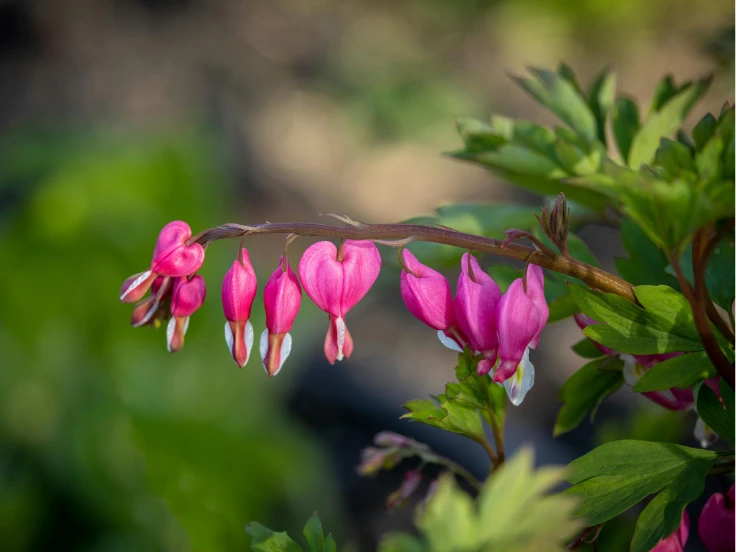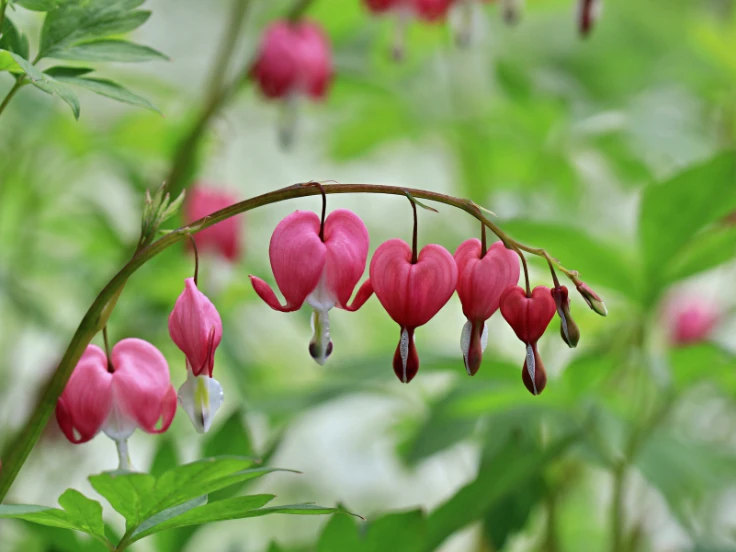Plants with heart shaped flowers are a charming addition to any garden, adding beauty, symbolism, and a touch of romance. These unique plants, such as Bleeding Heart and Hoya kerrii, are admired for their visually striking blooms and easy adaptability. Whether in home gardens, public parks, or botanical collections, a plant with heart shaped flowers instantly draws attention and enhances the overall garden aesthetic.
In addition, understanding their care requirements ensures that these plants flourish and maintain their heart-shaped blooms throughout the growing season. Factors such as sunlight, soil type, watering patterns, and fertilization are crucial to maximize their growth potential. Whether used in outdoor gardens or as indoor plants, these beauties bring a distinctive charm to every green space.
Popular Plant with Heart Shaped Flowers and Their Origins

Several plant species feature heart-shaped flowers, each with a unique origin and aesthetic appeal. For instance, the Bleeding Heart (Lamprocapnos spectabilis) originates from East Asia and is renowned for its arching stems adorned with delicate, dangling heart-shaped flowers. Similarly, the Hoya kerrii, commonly known as the “Sweetheart Plant,” is native to Southeast Asia and produces thick, succulent heart-shaped leaves that resemble flowers.
These plants often adapt well to different climates but thrive best in conditions mimicking their native habitats. Understanding their origin helps gardeners replicate suitable environments and achieve optimal flowering. Moreover, many of these plants are perennial, offering years of beauty with minimal maintenance.
Essential Care Tips for a Plant with Heart Shaped Flowers
To maintain the beauty of plants with heart-shaped flowers, gardeners must follow specific care guidelines. Proper care ensures healthy growth, vibrant blooms, and longevity. Additionally, providing the right amount of sunlight, water, and nutrients helps these plants thrive throughout the year.
- Sunlight: Most heart-shaped flowering plants prefer bright, indirect sunlight. Some species, like Bleeding Heart, thrive in partial shade.
- Watering: Consistent moisture is key, but avoid waterlogging. Soil should be well-draining to prevent root rot.
- Soil Requirements: Rich, loamy soil with good aeration is ideal for most species. Adding organic compost enhances nutrient availability.
- Fertilization: Use a balanced fertilizer during the growing season to promote vibrant blooms.
- Pruning: Regular removal of faded flowers encourages new growth and maintains the plant’s shape.
These steps not only preserve the plant’s aesthetic appeal but also encourage a healthy life cycle, ensuring that your garden remains full of vibrant, heart-shaped blooms.
Benefits of Growing a Plant with Heart Shaped Flowers
Growing plants with heart-shaped flowers offers multiple advantages beyond visual appeal. They also promote biodiversity by attracting pollinators like bees and butterflies, supporting a healthy garden ecosystem. Furthermore, these plants can uplift moods and create a calming, aesthetically pleasing environment in any space.
- Enhances garden aesthetics with unique shapes and vibrant colors.
- Symbolizes love, affection, and harmony in garden design.
- Attracts pollinators such as bees and butterflies, supporting local ecosystems.
- Serves as excellent gifts due to their romantic symbolism.
- Can be adapted for indoor decoration, providing a cozy, natural ambiance.
These benefits make them a popular choice for both novice gardeners and experienced horticulturists. Incorporating such plants into home gardens or public spaces like parks adds a unique touch that complements other floral varieties.
Heart-Shaped Flower Plants Suitable for Hamburg Gardens

For those exploring Hamburg places to visit, gardens and parks often feature plants with heart-shaped flowers. The city’s botanical spaces showcase species that thrive in temperate climates and offer stunning displays throughout the year. Examples include Bleeding Hearts, Hoya kerrii, and certain Cyclamen species.
These plants are not only aesthetically pleasing but also adapt well to Hamburg’s seasonal variations. Their presence in local gardens allows visitors to experience the unique charm of heart-shaped flowers firsthand. Moreover, gardeners in Hamburg can replicate similar conditions in their own backyard for year-round enjoyment.
Propagation Techniques for Heart-Shaped Flower Plants
Propagation ensures the availability of these plants for gardens and personal spaces. Most heart-shaped flowering plants can be propagated through seeds, cuttings, or division, depending on the species.
Understanding propagation methods allows gardeners to expand their collection sustainably. For instance, Bleeding Heart plants are often propagated through root division, while Hoya kerrii can grow from leaf cuttings. These techniques preserve the plant’s unique characteristics and enhance the garden’s diversity.
Seasonal Flowering and Care Adjustments

Heart-shaped flowering plants often have seasonal growth patterns, requiring gardeners to adjust care routines accordingly.During spring and early summer, most plants bloom prolifically, demanding regular watering and nutrient support. In contrast, some species enter dormancy during winter and need minimal maintenance. Adjusting care routines according to seasonal needs ensures continuous health and flower production.
- Monitor soil moisture to avoid overwatering during dormant periods.
- Reduce fertilization when growth slows.
- Protect sensitive plants from frost or extreme weather.
- Continue pruning faded flowers to prepare for the next flowering cycle.
Seasonal awareness maximizes bloom potential and prevents plant stress, making gardens more vibrant and resilient.
Designing Romantic Gardens with Heart-Shaped Flowers
Incorporating heart-shaped flower plants into garden design creates visually stunning and symbolic landscapes.Planners often use these plants to form focal points or pathways in romantic-themed gardens. Pairing them with complementary greenery enhances their visual impact. Additionally, potted arrangements near entrances or patios add elegance and charm.
- Combine heart-shaped blooms with climbing vines or trellises for vertical interest.
- Plant in clusters to create impactful color displays.
- Use contrasting foliage to highlight heart-shaped flowers.
- Incorporate garden sculptures or benches to enhance romantic aesthetics.
These design tips help gardeners craft spaces that evoke love and serenity, making them ideal for both private gardens and public parks.
Heart-Shaped Flower Plant Gifts: Unique and Meaningful
Heart-shaped flower plants are perfect gifts for expressing love and affection. Whether for anniversaries, birthdays, or special occasions, these plants convey emotions through natural beauty.Gifting a heart-shaped plant, like Hoya kerrii or Bleeding Heart, combines sentiment with sustainability, as these plants can thrive for years with proper care. In addition, they make excellent indoor decor, bringing warmth and greenery into living spaces.
- Choose potted plants for easy gifting and maintenance.
- Add personalized messages to enhance emotional value.
- Include care instructions for optimal growth.
- Select varieties with prolonged blooming periods for lasting impact.
By offering these plants as gifts, you provide both aesthetic pleasure and a meaningful symbol of love, making them memorable for recipients.
FAQs
Q1: Which plant has the most distinct heart-shaped flowers?
A: Bleeding Heart (Lamprocapnos spectabilis) is widely regarded for its iconic, pendulous heart-shaped flowers.
Q2: Can heart-shaped flower plants grow indoors?
A: Yes, species like Hoya kerrii adapt well to indoor conditions with sufficient sunlight and proper care.
Q3: Are these plants easy to propagate?
A: Most are relatively easy to propagate using seeds, leaf cuttings, or root division, depending on the species.
Conclusion
Plants with heart-shaped flowers not only combine aesthetic appeal and symbolic meaning, but also offer ecological benefits, making them ideal for gardens, indoor spaces, and gifts. Moreover, by understanding their care, propagation, and seasonal requirements, gardeners can enjoy vibrant blooms year after year. If you’re curious about which flowers return each season, check out our guide on perennial flowers to choose varieties that will thrive in your garden long-term.
In addition, for those exploring Hamburg places to visit, botanical gardens and parks provide excellent opportunities to witness these romantic blooms firsthand. Furthermore, incorporating these plants into garden design or gifting them to loved ones ensures that the charm and symbolism of heart-shaped flowers continue to inspire joy and beauty.
Consequently, these plants enhance both personal and public spaces. Similarly, they make thoughtful and meaningful gifts. Gardeners looking to expand their collection can also explore small flower perennial plants, which complement heart-shaped blooms beautifully. Therefore, gardeners can create lasting impressions with these flowers. As a result, the beauty and symbolism of heart-shaped flowers are preserved. Finally, their presence adds a romantic and enchanting touch to any environment.


















